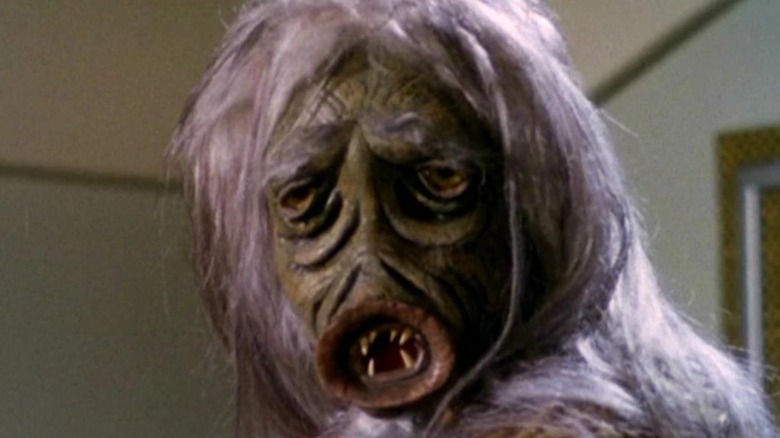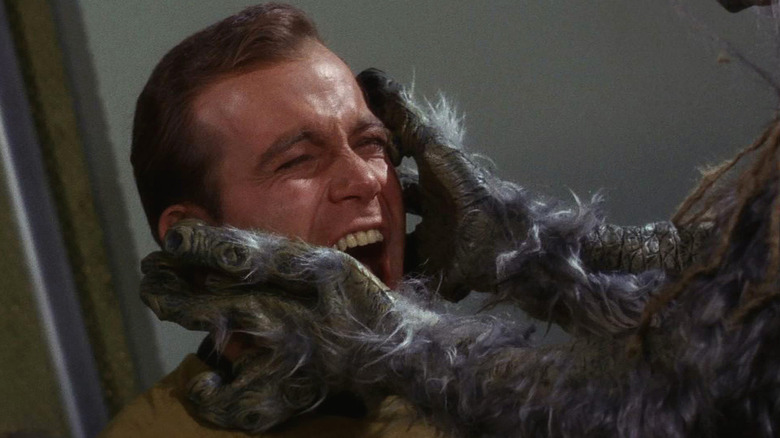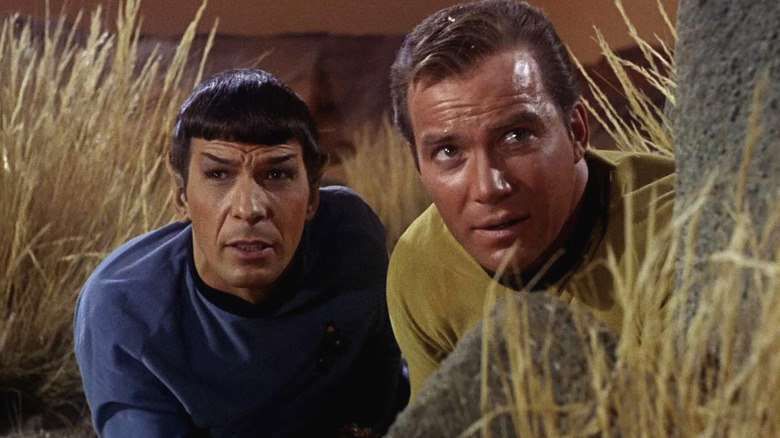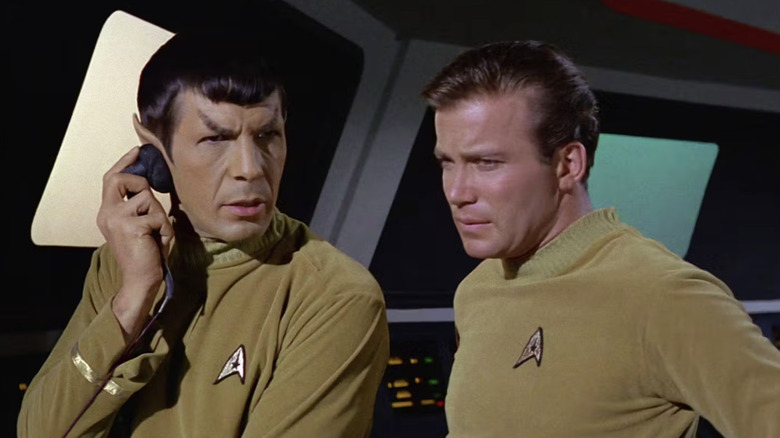Nobody But The Network Wanted The Man Trap To Be Star Trek's Series Premiere
"Star Trek: The Original Series" has three first episodes. Isn't this an irreconcilable contradiction? Let me explain.
There's the first produced "Star Trek" pilot, "The Cage," which starred Jeffrey Hunter as Captain Christopher Pike. When the Enterprise visits planet Talos IV, Pike is abducted by telepathic aliens the Talosians. NBC passed, feeling "The Cage" was a subpar effort, but let creator Gene Roddenberry take a second stab at it.
That resulted in "Where No Man Has Gone Before." When the Enterprise tries and fails to pass an energy field at the edge of the Milky Way galaxy, crewman Gary Mitchell (Gary Lockwood) develops psychic powers and goes mad.
The only thing that carries over between the two pilots is Leonard Nimoy as Mr. Spock. "Where No Man Has Gone Before" is closer to the finished series (it does star William Shatner as Captain James T. Kirk), but there are still noticeable differences. Scotty (James Doohan) and Mr. Sulu (George Takei) are present, but Dr. "Bones" McCoy (DeForest Kelley) and Lt. Uhura (Nichelle Nichols) are not. The costumes are different too; Starfleet uniforms are blue and yellow turtlenecks, made of thicker material than the later costumes and with no redshirts.
Had "Where No Man Has Gone Before" been the series premiere, these changes would be excusable. But instead, "Star Trek" greeted audiences with "The Man Trap" on September 8, 1966.
This one features the Enterprise visiting remote planet M-113, where McCoy's old flame Nancy Crater (Jeanne Bal) and her archaeologist husband Robert (Alfred Ryder) are the only human inhabitants. Unbeknownst to the main cast, Nancy is long dead and replaced by a native creature: a telepathic "salt vampire" which can use its abilities to, in essence, shapeshift from one form to another.
It's been well-documented that this episode wasn't the first "Star Trek" episode made for public consumption.
Why The Man Trap was the first Star Trek episode aired
Robert Justman and Herb Solow, who worked as producers on "Star Trek," shed some light on the series premiere selection when they wrote behind-the-scenes book "Inside Star Trek: The Real Story" together in 1966.
In August 1966, NBC held a screening of the available "Star Trek" episodes to decide which one should premiere the series. Despite being the pilot, "Where No Man Has Gone Before" was ruled out because it had too much exposition. The episode was "necessary for selling, not necessarily for televising," Solow opined. ("Where No Man Has Gone Before" aired as the show's third episode on September 22, 1966.)
Solow describes why each of the considered episodes was ruled out: Neither "The Corbomite Maneuver" or "The Enemy Within" had the scope needed for a series' premiere. "Mudd's Women" was too scandalous. "Charlie X," focusing on a psychic teenager, was "too gentle a tale."
So, the premiere selection came down to "The Man Trap" and "The Naked Time," where the Enterprise crew is exposed to a virus that removes their inhibitions. Justman pushed for "The Naked Time" (feeling its focus on character would quickly acquaint audiences with the "Star Trek" main cast), but NBC went with "The Man Trap" even though the crew thought it one of the weaker efforts. Why? Because "The Man Trap" was essentially a creature picture on a TV budget.
The reaction to The Man Trap
Interviewed for the 1995 book "Captains' Logs: The Unauthorized Complete Trek Voyages" by Edward Gross and Mark Altman, Justman compared this to his experience working on the sci-fi horror anthology "The Outer Limits," another program where the network demands chills and thrills.
"What the network wanted was not necessarily an intelligent science fiction show. What they wanted was a science fiction show that would return a lot of numbers. Their theory was that to do that you had to have a monster in every show."
Justman wasn't the only one with a low opinion of "The Man Trap." In William Shatner's 1993 memoir, "Star Trek Memories" (co-written with Chris Kreski), he laments that NBC chose the worst of the available episodes to premiere "Star Trek." Shatner assesses "The Man Trap" as "a dreadful show, one of our worst ever."
"The Man Trap" didn't quite set audiences' world on fire either. The September 14, 1966 issue of Variety included a panning review of "The Man Trap." The reviewer was evidently so displeased, he didn't even bother spelling Nimoy's name correctly.
"'Star Trek' with William Shatner ... won't work. An Incredible and dreary mess of confusion trudged on for a long hour with hardly any relief from violence, killings, hypnotic stuff, and a distasteful, ugly monster."
Leonard Nimoy himself would triumphantly read this review to a live audience years later, as included in the 2016 documentary about his life, "For The Love of Spock."
On the other hand, Bill Ornstein's 1966 review for The Hollywood Reporter says that "The Man Trap" will "please sci-fi buffs to no end" and concludes that "['Star Trek'] should be a winner." Evidently, not only NBC executives saw promise in the episode.
Is The Man Trap a good Star Trek episode?
The lamentations surrounding "The Man Trap" are mostly that it ensured "Star Trek" didn't put its best foot forward first. Audiences who tuned in on that fateful September 1966 day could walk away with the first impression that "Star Trek" was only a corny science-fiction monster show. The episode combines the feeling of a Western (M-113 is like a frontier outpost) and a horror B-picture. A predatory alien in the midst of a human crew slowly picking them off; am I talking about "The Man Trap" or "The Thing From Another World"? In other words, not the most intellectual storytelling.
Remember, though, one reason "Star Trek" endures as the best science-fiction franchise we have is its variety. There's equal room for pulpy episodes like "The Man Trap" and more thoughtful ones like "Where No Man Has Gone Before." Was it the best call to begin the series with one of the dumber ones? Perhaps not, but I enjoy when "Star Trek" embraces horror. It fits into the franchise ethos of exploration, but flips it; not every corner of the galaxy is a friendly place.
I'd still recommend that new Trekkies begin with "Where No Man Has Gone Before," but "The Man Trap" is effective at showing another side of "Star Trek."



